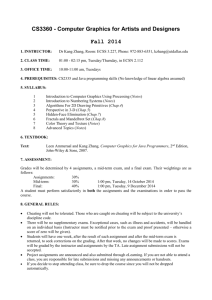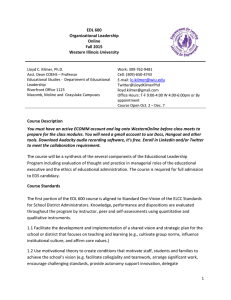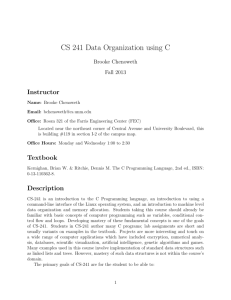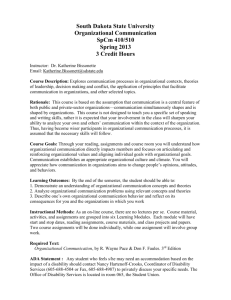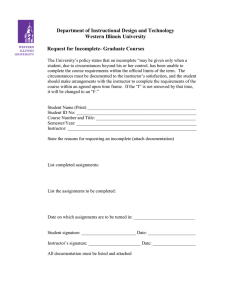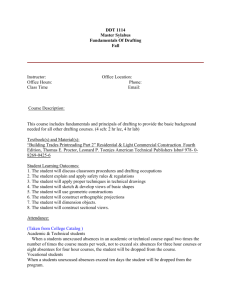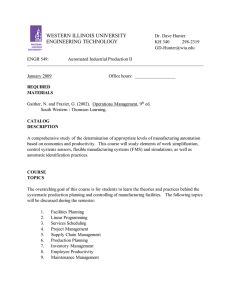EDL 600 Organizational Leadership Fall 2014 Western Illinois University
advertisement
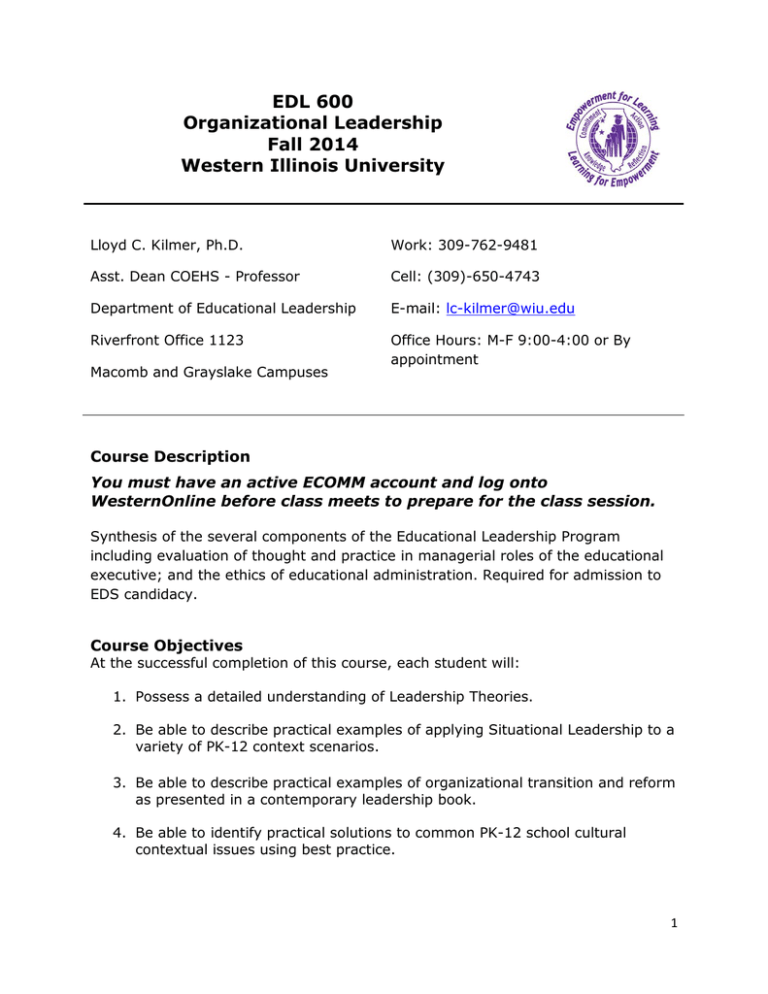
EDL 600 Organizational Leadership Fall 2014 Western Illinois University Lloyd C. Kilmer, Ph.D. Work: 309-762-9481 Asst. Dean COEHS - Professor Cell: (309)-650-4743 Department of Educational Leadership E-mail: lc-kilmer@wiu.edu Riverfront Office 1123 Office Hours: M-F 9:00-4:00 or By appointment Macomb and Grayslake Campuses Course Description You must have an active ECOMM account and log onto WesternOnline before class meets to prepare for the class session. Synthesis of the several components of the Educational Leadership Program including evaluation of thought and practice in managerial roles of the educational executive; and the ethics of educational administration. Required for admission to EDS candidacy. Course Objectives At the successful completion of this course, each student will: 1. Possess a detailed understanding of Leadership Theories. 2. Be able to describe practical examples of applying Situational Leadership to a variety of PK-12 context scenarios. 3. Be able to describe practical examples of organizational transition and reform as presented in a contemporary leadership book. 4. Be able to identify practical solutions to common PK-12 school cultural contextual issues using best practice. 1 5. Be able to describe the match, or mismatch, of leadership skills and dispositions to different organizational settings. EDL Mission: To prepare transformational leaders who cultivate exemplary learning organizations. EDL Vision: To be a premiere Ed Leadership program in the country. We will accomplish our vision through: recruiting a capable, diverse student body; focusing on continuous improvement of our programs; creating meaningful clinical internship experiences; and continuing to cultivate internal and external relationships. Course Standards The first portion of the EDL 600 course is aligned to Standard One-Vision of the ELCC Standards for School District Administrators. Knowledge, performance and dispositions are evaluated throughout the program by instructor, peer and selfassessments using quantitative and qualitative instruments. 1.1 Facilitate the development and implementation of a shared vision and strategic plan for the school or district that focuses on teaching and learning (e.g., cultivate group norms, influence institutional culture, and affirm core values.) 1.2 Use motivational theory to create conditions that motivate staff, students and families to achieve the school's vision (e.g. facilitate collegiality and teamwork, arrange significant work, encourage challenging standards, provide autonomy support innovation, delegate responsibility, develop leadership in others, provide leadership opportunities, recognize and reward effective performance, provide knowledge of results, provide coaching and mentoring, gain resources, serve as a role model). 1.3 Frame, analyze and resolve problems using appropriate problem- solving techniques and decision-making skills (e.g., identify problem, seek and analyze problem factors, collect and organize relevant information, identify causes, seek creative solutions, apply ethical standards, determine best solution with others when appropriate.) 1.4 Initiate, manage, and evaluate the change process. 2 1.5 Identify and critique several theories of leadership and their application to various school environments. 1.6 Act with a reasoned understanding of the major historical, philosophical, ethical, social and economic influences affecting education in a democratic society. 1.7 Manifest a professional code of ethics and values. Required Texts Introduction to Leadership: Concepts and Practice, Peter G. Northouse, Third Edition Sage Publishing, 2015, ISBN978-1-4522-5966-6 Select and read one of the following Classic Leadership Books for Review and Response: Good to Great – Collins Team of Rivals – Kearns (Not for the faint of heart) Onward – Schultz Drive – Pink Moneyball – Lewis COURSE SCHEDULE EDL 600 Organizational Leadership This schedule is very flexible and subject to change due to the needs of this course. Students are expected to have read the materials in order to be prepared for the discussions. Class Modules In Class Focus Readings and Responses Unit 1 Approaches to Leadership Read Chapters 1-4 in Assignments Due One Current Event Article to share in 3 *See Appendix A - Online Requirements Discovering your Strengths Introduction to Leadership Situational Leadership Complete one Observational Exercise and Reflection/Action Worksheet text for each chapter. Post online on discussion board Shaw Presentation Search Activity Global Talent Challenge Sample Interactive Presentation class. Three Tweets or Linkedin Posts in your log. View Jobs TED talk Kearns TED talk Unit 2 Visioning Read Managing Transitions Chapters 5-8 Relationships – Heart of Change Observation and Reflection Worksheets Strategic Planning Simulation APA Guidelines – Library Intro One Current Event Article Three Tweets or Linkedin Posts View Kotter TED talk Branson TED talk SAM Research Unit 3 Tending to Constituents Ethics Read Chapters 9-12 Observation and Reflection Leading Teams: Cultural/Generational Worksheets awareness View Implementation Google TED talk Climate and Culture Building Activity One Current Event Article Leadership Paper TBA Peer Editing Individual Issue Presentation in class 4 Policy Formation – Early Childhood Activity 5 Point Values for the Course Assignments ASSIGNMENTS POINTS Text - Discussion Activities 120 PK-12 Articles and Social Media Posts 80 Leadership Paper 100 Issue Review Presentation 100 Review and Response – Business Book 100 Total 500 Project Assignments Review and Respond Choose a current book about leadership that interests you and use MicroSoft® PowerPoint® to present a short book report. Your presentation should be equivalent to about five minutes and include key points and an explanation of why you found the book interesting. Post your presentation as indicated under the “Discussions” tab in WOL. Issue Literature Review Interview an acting superintendent for the purpose of 1) identifying one major issue that the district wants researched to assist with its planning and growth, and 2) demonstrating an analysis of the school district's legal, ethical, demographic, historical, political, social, cultural, racial, and ethnic contexts in determining the best research-based recommendation regarding the selected issue. Using information gained from the interview, current research, and reflection, use a Prezi or SpicyNodes to prepare a literature review presentation related to the critical issue identified. Presentations should be equivalent to about ten to fifteen minutes in length and include at least five research articles. Post your presentation as indicated under the “Discussions” tab and present during weekend three. 6 Leadership Paper Prepare a 400-500 word paper which states your personal perspective on leadership and effective organizations. It should be written in APA format and include at least five references from the materials read or viewed for class or other related materials. Include a reference list in APA form. Peer editing will be completed in weekend three class. Policies and Expectations Incomplete Grade for Missing Course Requirements An incomplete grade may be given only when a student, due to circumstances beyond his or her control, is unable to complete course requirements within the official limits of the term. The instructor may allow additional time for completion of the requirements after consideration of a written petition from the student to the instructor. The petition must include what the student will do to complete the requirement and the expected date of completion of the incomplete requirements. Academic Accommodations In accordance with University policy and the Americans with Disabilities Act (ADA), academic accommodations may be made for any student who notifies the instructor of the need for an accommodation. For the instructor to provide the proper accommodation(s) you must obtain documentation of the need for an accommodation through Disability Support Services and provide it to the instructor. It is imperative that you take the initiative to bring such needs to the instructor's attention, as he/she is not legally permitted to inquire about such particular needs of students. Students who may require special assistance in emergency evacuations (i.e. fire, tornado, etc.) should contact the instructor as to the most appropriate procedures to follow in such an emergency. Contact Disability Support Services at 298-2512 for additional services. In accordance with the provisions of the ADA, if you require any special assistance or adaptations in this course, please contact the instructor immediately. WIU Academic Dishonesty Policy Western Illinois University is dedicated to the discovery and communication of knowledge. The University can best function and accomplish its objectives in an atmosphere where high ethical standards prevail. For this reason, and to insure that the academic work of all students will be fairly evaluated the University strongly condemns academic dishonesty. The most prevalent forms of academic dishonesty are cheating and plagiarism. Dishonesty of any kind with respect to examinations, course assignments, alteration of records, or illegal possession of examinations shall be considered cheating. It is the responsibility of the student to 7 not only abstains from cheating, but also to avoid making it possible for others to cheat. Any student who knowingly helps another student cheat is as guilty of cheating as the student he or she assists. The submission of the work of someone else as one's own constitutes plagiarism. Academic honesty requires that ideas or materials taken from another course for use as a course paper or project be fully acknowledged. Plagiarism is a very serious offense in whatever form it may appear, be it submission of an entire article falsely represented as the student's own, the inclusion within a piece of the student's writing of an idea for which the student does not provide sufficient documentation, or the inclusion of a documented idea not sufficiently assimilated into the student's language and style. The following is a link to WIU’s Policy on Academic integrity: http://www.wiu.edu/policies/acintegrity.php. Student Rights and Responsibilities A complete set of links to student rights and responsibilities can be found at the following URL: http://www.wiu.edu/Provost/students Grading Scale A 94-100% or 470 to 500 points A- 93% or 465 to 469 points C+ 83% or 415 to 419 points C 75-82% or 375 to 414 points B+ 92% or 460 to 464 points B 85-91% or 425 to 459 points B- 84% or 420 to 424 points F 413 points or less A work exceeds requirements in some form, shows originality and clarity, insightful and reflective. B work thoroughly meets requirements and is coherent with only minor flaws. C work minimally addresses requirements and contains flaws or shortcomings. NOTE: This course syllabus is not a contract, but serves as an outline for the semester. The instructor reserves the right to make adjustments the course as the need arises. 8 Appendix A Detailed Explanation of Online Requirements Revised: Fall 2014 Text Discussions, PK-12 Discussions, Q&A Discussions and Case Studies For each chapter in the Northhouse text write and post your Observational Exercise and Reflection/Action Worksheet on the appropriate Discussion Board. Be concise. Chap. 1 You may use three TED talks or speak to three educational leaders (K-12 or College). Chap. 2 As is. Chap. 3 Use a district colleague or teacher leader/ coach within your building. Chap 4 As is Chap. 5 As is Chap. 6 As is Chap. 7 Use two leaders and conduct a 20 minute interview. 9 Chap. 8 Reflect on your style in conducting a meeting of staff, parents or colleagues. Chap. 9 As is Chap. 10 Use a student discipline or staff issue (keep names confidential) Chap. 11 Optional – do only if convenient. Chap 12 Write a paragraph describing your ways of overcoming obstacles. Also, for each chapter, post a response to one other classmate’s post to one of the reflections Appendix B Class Participation In addition to contributing to class discussions both during class time and online, you will need to be prepared to share a current event related to course topics during each in-class session (one per weekend). Tweets, article postings on Linkedin or other locations. Appendix C Article or Current Event Analysis “Analyzing the Message” 1) What is the main purpose of this article? 10 2) What concept/s or information would the reader need to know in order to fully understand this article? List any terms or concepts in the article that you do not understand? 3) What are the key questions or issues the author is addressing in this article? 4) What is the main point of view presented by the author of this article? OR What are the main assumption(s) underlying the author’s thinking? 5) If readers take the article seriously, what conclusions might they draw from the article? 6) What are 1-2 key points that you want to remember from this article? Appendix D Feedback on Assignments I will be using the Written Assignment Feedback Form and the Oral Presentation Feedback Form as a guide to grade all written and presentation work. These forms are printed below. 11 Guidelines for grading written assignments will follow APA format and the rubric printed below. WRITTEN ASSIGNMENT FEEDBACK Student/Group Name(s) Date Course Assignment Content/Development 50% Subject Matter: • Key elements of assignments covered • Content is comprehensive/accurate/persuasive • Displays an understanding of relevant theory • Major points supported by specific details/examples • Research is adequate/timely • Writer has gone beyond textbook for resources Higher-Order Thinking: • Writer compares/contrasts/integrates theory/subject matter with work environment/experience • At an appropriate level, the writer analyzes and synthesizes theory/practice to develop new ideas and ways of conceptualizing and performing Organization 20% • • • • • The introduction provides a sufficient background on the topic and previews major points Central theme/purpose is immediately clear Structure is clear, logical, and easy to follow Subsequent sections develop/support the central theme Conclusion/recommendations follow logically from the body of the paper Style/Mechanics 30% Format--10% • Citations/reference page follow guidelines • Properly cites ideas/info from other sources • Paper is laid out effectively--uses, heading and other reader-friendly tools • Paper is neat/shows attention to detail Grammar/Punctuation/Spelling--10% • Rules of grammar, usage, punctuation are followed • Spelling is correct Readability/Style--10% • Sentences are complete, clear, and concise • Sentences are well-constructed with consistently strong, varied structure • Transitions between sentences/paragraphs/sections help maintain the flow of thought • Words used are precise and unambiguous • The tone is appropriate to the audience, content, and assignment 12 Guidelines for grading oral presentation assignments will follow the rubric printed below. Oral Presentation Feedback Student/Group Name(s) Date Course Assignment Content (30%) -Presentation content clearly follows the written paper upon which it is based (if applicable) -Topic is relevant and addresses assignment specifications -Content presented is comprehensive, accurate, and believable -Key points are noted -Topic is researched adequately Organization/Structure (20%) -Presentation is well-organized, clear, and effectively structured -If this is a group presentation, it is integrated rather than being a disjointed series of individual presentations -There is an introduction to gain the audience’s attention and explain the purpose of the presentation Style/Presentation/Appearance (15%) -Dress and grooming are appropriate to the setting -Non-verbal cues/gestures are appropriate to presentation and flow of ideas -Content knowledge/confidence are evident -Time was used well/not rushed Use of Visual Aids (15%) -Visual aids are used where appropriate -Visual aids are appropriately professional given the presentation’s context -They are easy to see/read -Media are used correctly--i.e., overheads, videos, computer generated slides, charts, etc. -Visual aids contribute to the overall effectiveness of the presentation Audience Participation (10%) -The presenter(s) involved the audience and solicited feedback -Questions from the audience are effectively addressed and answered correctly Adherence to Time Limit (10%) -The presenter(s) stayed within the allotted time limit (Failure to do so may result in a deduction of points) 13
